
Image: Matt Smith / Foundry
Working from home has gone from being a growing trend to a full-scale phenomenon. There are many perks to a work-from-home arrangement, to be sure, but there can also be downsides: For example, there’s a good chance you’ll need to supply your own monitor. Fortunately, there are many great home office monitors to choose from, as I’ve discovered through extensive real-world testing.
Below you’ll find my picks for the best home office monitors, and below that you can learn more about what specs and features matter when shopping for a home office monitor.
For even more monitor recommendations, check out our roundups of the best monitors and the best portable monitors. The latter can be especially useful if you like to be able to work from locations in and out of the home.
Updated 11/22/2023: We’ve added the BenQ GW2790QT as our choice for best 1440p home office monitor. Read more about this exciting new pick, perfect for the home office, in our summary below.
Philips Creator Series 27E2F7901 – Best home office monitor

Pros
IPS Black panel improves contrast ratio
Excellent color gamut and accuracy
Sharp 4K image
USB-C connectivity with Power Delivery, DisplayPort-Out
Cons
Generic design
Awkward on-screen menu system
Lackluster HDR, 60Hz refresh rate
Philips’ Creator Series 27E2F7901 is an ideal home office monitor. It offers a 27-inch display with IPS Black panel technology, useful connectivity, and excellent image quality.
Its IPS Black display panel is a recent technology that significantly enhances the contrast ratio compared to older IPS monitors, which in turn provides a deeper, more immersive image. Its color gamut and accuracy are commendable, too, and its 4K resolution means web pages, photos, and PDFs look razor-sharp.
Connectivity is another strength. The 27E2F7901 accepts video over HDMI, DisplayPort, and USB-C, with the latter also serving as a USB hub for multiple downstream USB ports. The USB-C port can charge devices that require up to 96 watts of power. It has DisplayPort-Out, as well, an uncommon connection that can connect a second monitor directly to the Philips.
The monitor’s design is not as attractive as Dell’s Ultrasharp series but retains the features most people need. It ships with an ergonomic stand that adjusts for height, tilt, swivel, and pivot. The monitor also has an adapter for use with 100x100mm VESA mounts, making third-party monitor arms and stands an option.
Though excellent, the 27E2F7901 isn’t perfect. The on-screen menu system can be cumbersome to navigate. HDR is supported, but the monitor’s HDR performance leaves a lot to be desired. And its humble 60Hz refresh rate will disappoint gamers.
These downsides are shared with many competitors, however, and forgiven by Philips’ pricing. The 27E2F7901 retails for just $499.99. Though not inexpensive, it undercuts similar home office monitors from Dell and LG by roughly $100. It’s a value leader that simultaneously delivers top-tier connectivity and image quality.
Read our full
Philips Creator Series 27E2F7901 review
Acer K242HYL – Best budget home office monitor
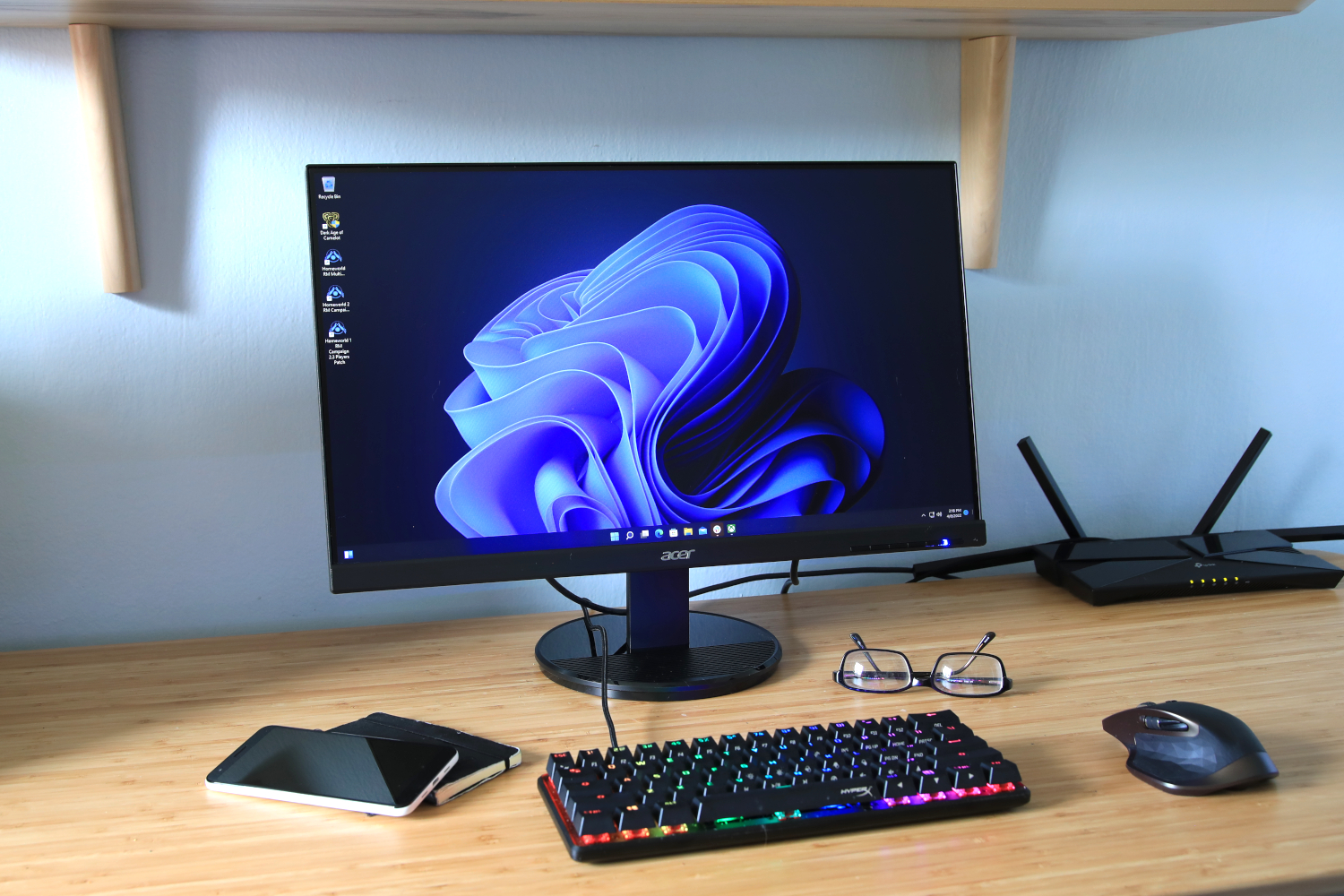
Pros
Attractive color accuracy and gamut
Acceptable sharpness for a 1080p display
Avoids motion clarity pitfalls
Menu system is easy to use
Cons
Barebones design
No height adjustment on stand
Only one HDMI, no DisplayPort
Power LED is very bright
Want a basic home office monitor that can handle most tasks at a very low price? The Acer K242HYL is it.
Acer’s K242HYL is a 24-inch, 1080p monitor. It’s not as sharp as a premium, 4K monitor, but image clarity is not bad for a monitor in this price bracket. The K242HYL also packs a respectable maximum brightness of almost 300 nits, good color accuracy, and supports 98 percent of the sRGB gamut. None of these figures are record breaking, but they’re great for a budget monitor.
The monitor lacks a height-adjustable stands, but this is common at this price. A VESA monitor stand mount is available for adding a third-party monitor stand. Video connectivity is limited to just one HDMI and one VGA. The monitor does throw in a few perks, though, including AMD FreeSync support for smooth gaming and a slightly enhanced 75Hz refresh rate.
Often priced at just $99.99, the Acer K242HYL is an impressive value. It’s the least capable monitor on this list, to be sure—but it’s more than adequate for document editing, accounting, project management, video conferencing, and hundreds of other home office tasks.
Read our full
Acer K242HYL review
Asus ProArt PA279CRV – Best 4K home office monitor
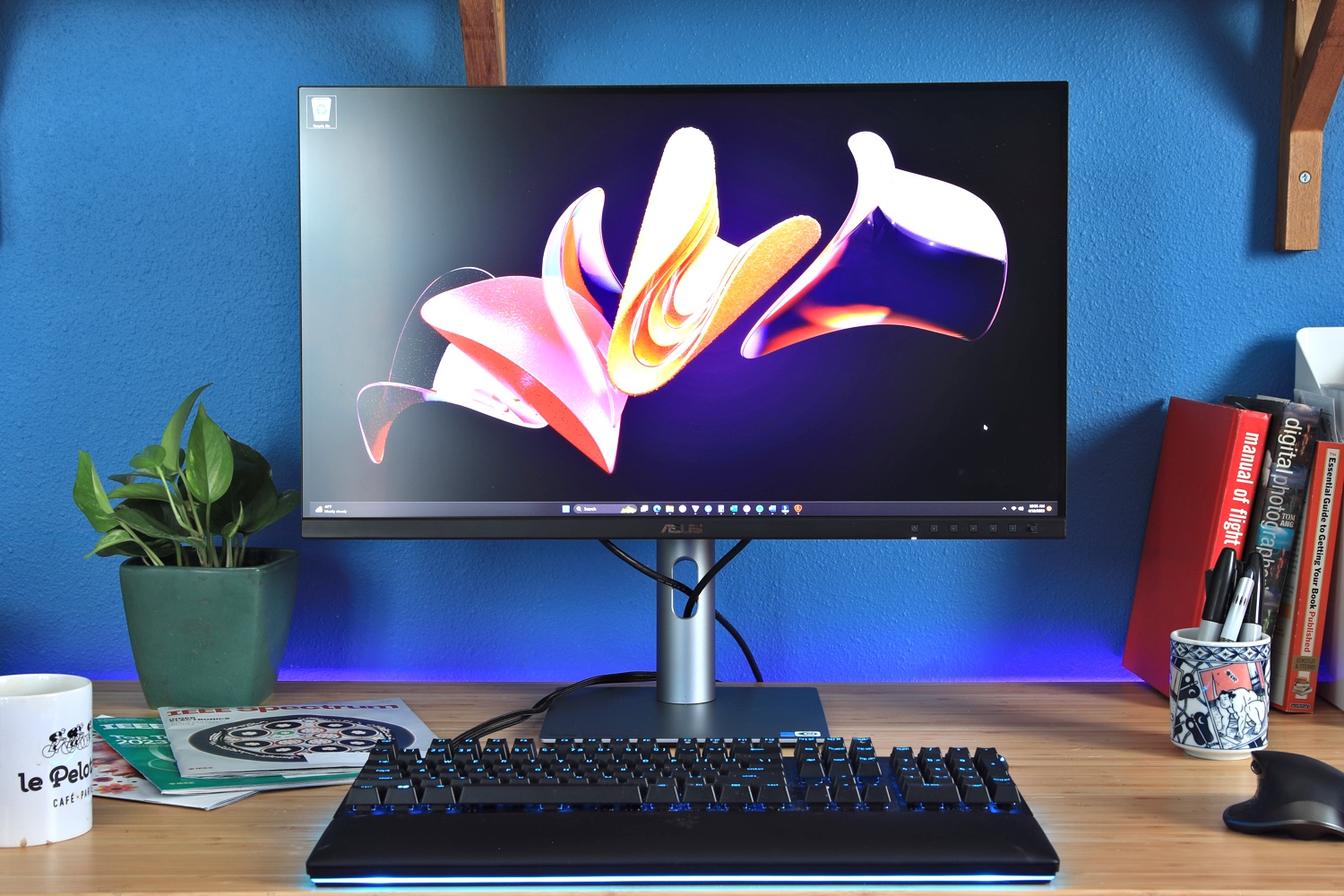
Pros
Plenty of connectivity
Numerous image-quality options
Extremely wide color-gamut
Good value for money
Cons
Mediocre contrast and brightness
Subpar HDR performance
Unimpressive motion clarity
The Asus ProArt PA279CRV is an outstanding home office monitor for professionals, artists, and creators seeking exceptional color performance at an affordable price.
It has a 27-inch 4K display that packs 163 pixels per inch. That translates to outstanding sharpness and clarity across apps, web pages, movies, and games. The monitor also has a remarkably wide color gamut that rivals more expensive displays, covering 100 percent of sRGB, 99 percent of DCI-P3, and 98 percent of AdobeRGB.
Asus pairs the monitor’s excellent image quality with elegant design and a sturdy, ergonomic stand that supports height, tilt, swivel, and pivot adjustments. The monitor’s extensive connectivity options include USB-C with DisplayPort Alternate Mode and 96 watts Power Delivery, two DisplayPort 1.4 (including one output supporting Daisy Chain), two HDMI 2.0, and three USB-A 3.2 Gen-1 ports, as well as a 3.5mm audio-out.
The PA279CRV has a mediocre contrast ratio and struggles with detail and ambiance in dark content. It also offers a modest 60Hz refresh rate, which amounts to lackluster motion fluidity in games.
These downsides are easily excused by Asus’ competitive MSRP of $469. That’s an extremely low price for a monitor that offers 4K resolution and top-tier color gamut alongside gobs of ports.
Read our full
ProArt PA279CRV review
BenQ GW2790QT – Best 1440p home office monitor

Pros
Attractive and ergonomic design
Sharp, bright image
Includes USB-C and DisplayPort-out
Acceptable built-in speakers and microphone
Cons
Mediocre image quality
No HDR
No Adaptive Sync
The BenQ GW2790QT is a great choice for a budget-friendly 1440p home office monitor. Priced at $300 (occasionally dropping to $280 on Amazon), it delivers a crisp and bright 27-inch IPS display with a resolution of 2560×1440. It also has built-in speakers and even a microphone, which is helpful for video conferencing.
Connectivity is extensive. It includes USB-C with 65 watts of Power Delivery and DisplayPort Alternate Mode, HDMI, DisplayPort, three USB-A 3.2 downstream ports, and a 3.5mm audio jack. It also has DisplayPort-out, an uncommon port that lets you reduce cable clutter by daisy-chaining video from the GW2790T to a second monitor.
BenQ provides an excellent ergonomic stand that adjusts for height, tilt, swivel, and pivot. It has a heavy base that keeps the monitor firmly planted on your desk. The base is flat, so other objects can be placed on top of it, and it takes the unusual step of including a cut-out that can be used as a smartphone or tablet stand.
The monitor has one weakness: It’s perhaps too focused on home office use. It doesn’t have gaming features like AMD FreeSync or Nvidia G-Sync and lacks HDR support. That’s easy to forgive, however, given the monitor’s mid-range $300 price tag. It’s not the best for every situation, but it’s excellent for a home office.
Read our full
BenQ GW2790QT review
Dell Ultrasharp U4924DW – Best super-ultrawide home office monitor
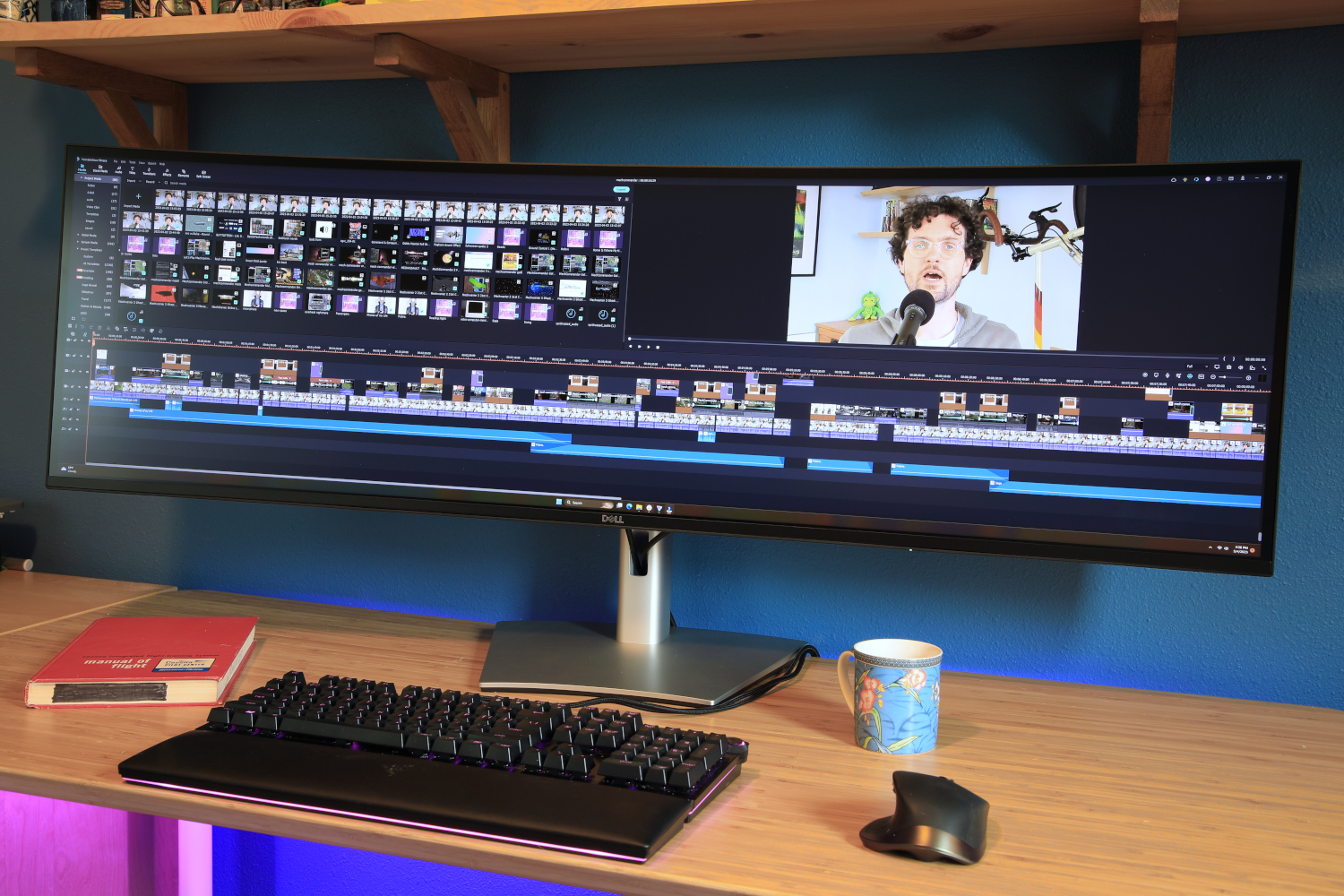
Pros
Excellent build quality and stand
Lots of connectivity including USB-C
Easy-to-use menu with numerous options
IPS Black improves contrast ratio
Cons
Image quality is mediocre overall
No HDR or Adaptive Sync
Expensive for its feature set
The Dell Ultrasharp U4924DW is ideal for home office workers who want a super-ultrawide monitor with USB-C capabilities. Although the display is curved, the curve is more subtle than most monitors of the same size. This improves the user experience by reducing the visual distortion a curved display can introduce.
Dell provides many small touches that make the monitor easy to use in a home office. The stand is sturdy yet small, which leaves more space free on your desk. It also has VESA mount options for both 200x100mm and 100x100mm mounts, providing wide support for third-party monitor arms, stands, and even wall mounts. The monitor supports picture-in-picture and picture-by-picture modes and can be used to view two input devices at once.
The U4924DW stands out with top-notch USB-C connectivity. It provides a USB-C hub with six downstream USB ports (four USB-A, two USB-C), ethernet, and audio-out. These are driven by a USB-C port supporting DisplayPort Alternate Mode and delivering 90 watts of Power Delivery. You can connect and charge a laptop or tablet with a single USB-C cable.
Although it has many perks, the U4924DW lacks HDR support and has a modest 60Hz refresh rate. This puts the monitor behind alternatives available at its intimidating $1,999 MSRP. Image quality is otherwise excellent, however, and these features are mostly a concern for entertainment, not productivity.
Read our full
Dell Ultrasharp U4924DW review
Dell 2424T – Best touchscreen home office monitor

Pros
Easy-to-use touchscreen
Unique tilt stand
Excellent USB-C connectivity
Good contrast ratio
Cons
Expensive for its size and resolution
Image quality is good, but not amazing
No Adaptive Sync or HDR
Price When Reviewed:
399 Euro
The Dell 2424HT is an excellent monitor for those craving a touchscreen experience for their home office. With its 24-inch display, 1080p resolution, and 10-point multi-touch panel, it provides an intuitive touch experience for navigating through documents, spreadsheets, and presentations.
Dell improves the touchscreen experience with a versatile tilt stand that lets you adjust the angle of the screen for comfortable viewing and easy touchscreen access. The monitor also delivers excellent connectivity with USB-C, HDMI, and DisplayPort inputs. The USB-C port provides USB Power Delivery, which can charge a connected laptop or tablet. It also serves as a USB hub providing additional USB-A ports and Ethernet.
The 2424HT delivers solid image quality for office work with good color accuracy, contrast, and viewing angles thanks to its IPS panel. It sticks to a 60Hz refresh rate, however, and lacks Adaptive Sync. The 2424HT’s purpose is clear: It’s for work, not gaming.
Dell asks a steep $519.99 MSRP, but the monitor is sometimes discounted to $414.99. That makes the Dell 2424HT more expensive than its alternatives, but it makes up for that with superior image quality and connectivity. These advantages make the 2424HT the obvious choice if you want a touchscreen monitor for your home office.
Read our full
Dell 2424HT review
Viewsonic VG2756V-2K – Best home office monitor for video calls
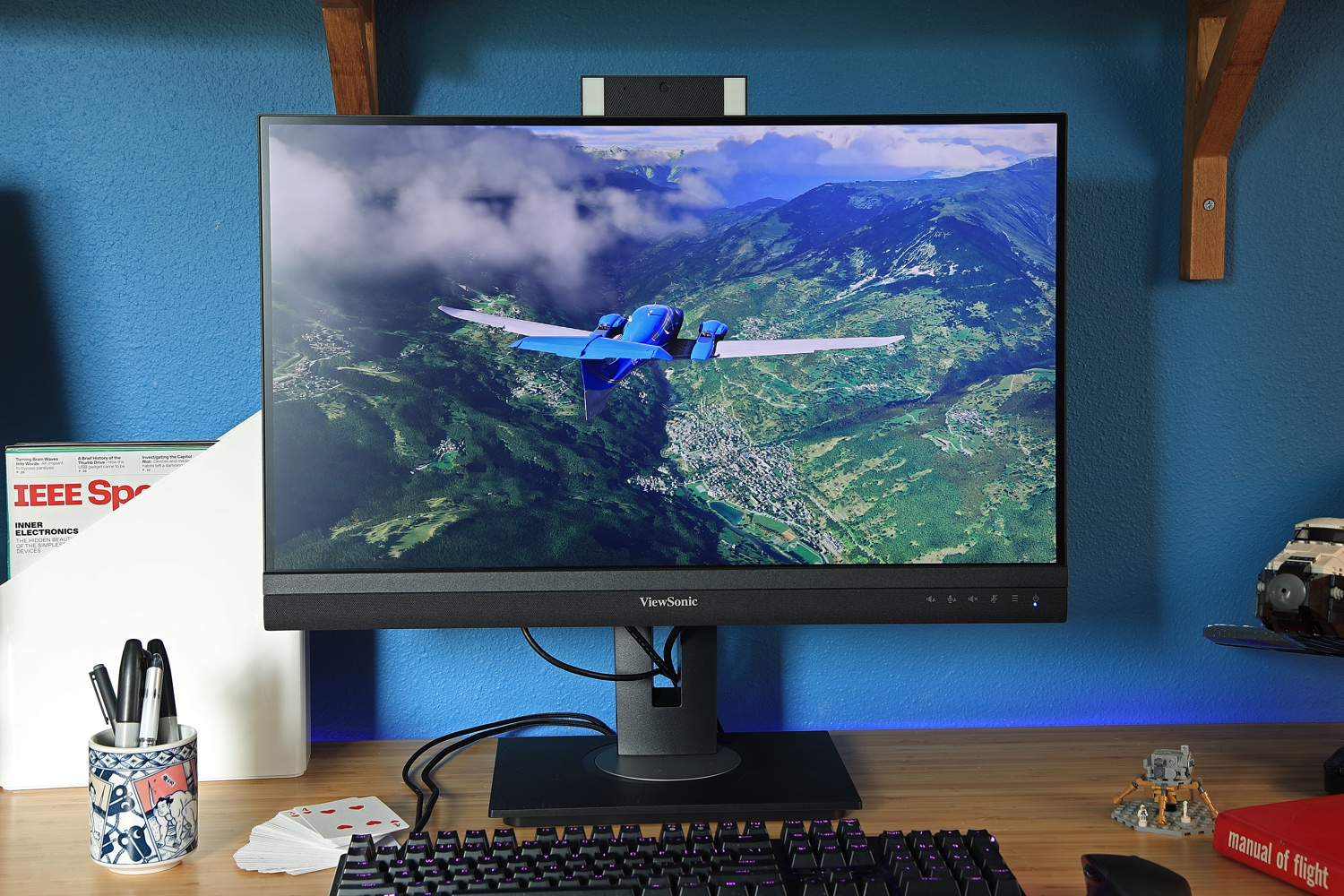
Pros
Bundled webcam, microphone, and speakers
USB-C port with 90 watts power delivery
Sturdy and functional design
Cons
Mediocre image quality
No HDR
Bundled features add to the price
Viewsonic’s VG2756V-2K is a 27-inch home office monitor with a built-in webcam, noise cancelling microphone, and speakers.
The integrated 1080p webcam provides a clear step up from a typical laptop webcam. An integrated lightbar is provided to brighten dark rooms and the entire camera assembly can retract into the monitor, effectively acting as a privacy shutter. The built-in soundbar has two 5-watt speakers that deliver good volume and crisp audio for video or audio calls. They’re paired with a noise-cancelling microphone that prevents echoes and can eliminate most soft, repetitive sounds.
Viewsonic includes a wide range of connectivity. The monitor has a USB-C with DisplayPort Alternate Mode and 90 watts of Power Delivery for charging a connected device. It also acts as a USB-C hub that powers two USB-A ports and an ethernet connection. Video inputs include HDMI and DisplayPort for a total of three video inputs.
Image quality is good with excellent sharpness, adequate brightness, and an acceptable contrast ratio. The VG2756V-2K does not support HDR, however, and is not recommended for gaming due to its 60Hz refresh rate and lack of Adaptive Sync.
The Viewsonic VG2756V-2K is competitively priced with an MSRP of $399. That’s expensive for a 27-inch 1440p monitor, but the premium you’re paying for the monitor’s bundled features is less than you’d pay for a webcam, microphone, and desktop speakers purchased individually. That makes the VG2756V-2K a good value and worthwhile business expense.
Read our full
Viewsonic VG2756V-2K review
Acer Vero BR277 – Best eco-friendly home office monitor
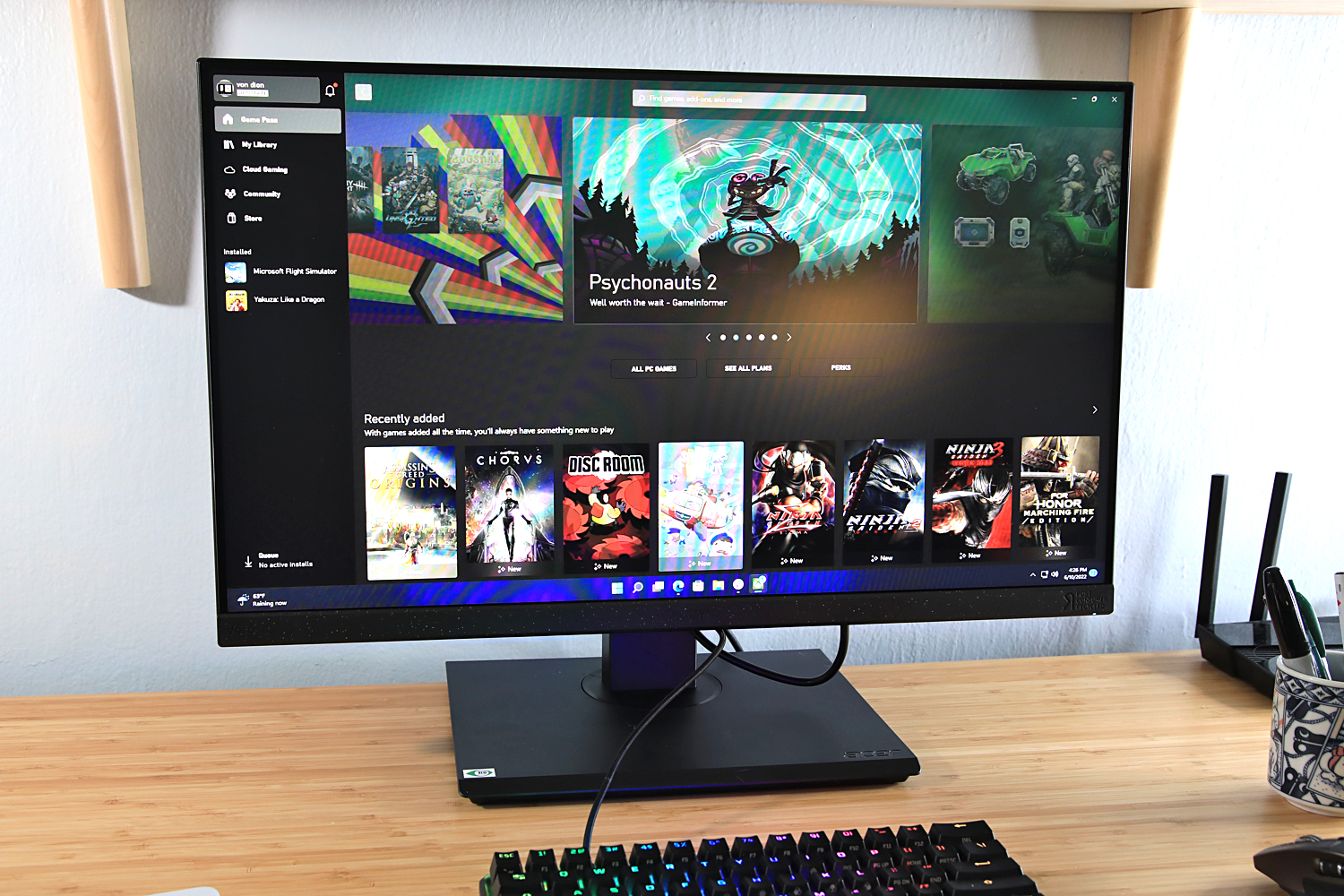
Pros
Good contrast ratio
Solid build quality
Accurate, realistic color
Uses recyclable plastics, packaging also recyclable
Cons
Below-average sharpness
Limited color gamut
No single standout feature
Concerned about the ecological impact of your home office? You should be. Global E-waste is currently estimated at 53.6 megatons per year and, of course, it’s growing. Acer’s Vero BR277 isn’t going to solve this problem on its own—but it tries.
The Acer Vero BR277, like other Acer Vero products, is partially built from Post-Consumer Recycled Plastics. Despite what you may think, these plastics feel robust. They also have a unique flecked look that stands out from other, less visually interesting designs.
How the monitor is built wouldn’t matter if it was junk—thankfully, it’s quite good. This is a 27-inch 1080p monitor with a respectable maximum brightness of just over 300 nits. The monitor’s color gamut is a bit limited at just 97 precent of sRGB, but it scores well in color accuracy and contrast. The result? Bright, pleasant, realistic image quality.
The monitor has an ergonomic stand that adjusts for height, swivel, and tilt. It also supports AMD FreeSync for smooth gaming and has a maximum refresh of 75Hz.
Pricing is competitive. The monitor originally released at an MSRP of $249.99 but can now be found as low as $169.99. That’s a great price for a home office monitor with good image quality and a height-adjustable stand. Acer also has a 24-inch model, which is even less expensive at $129.99.
Read our full
Acer Vero BR277 review
Asus ZenScreen MB249C – Best second monitor
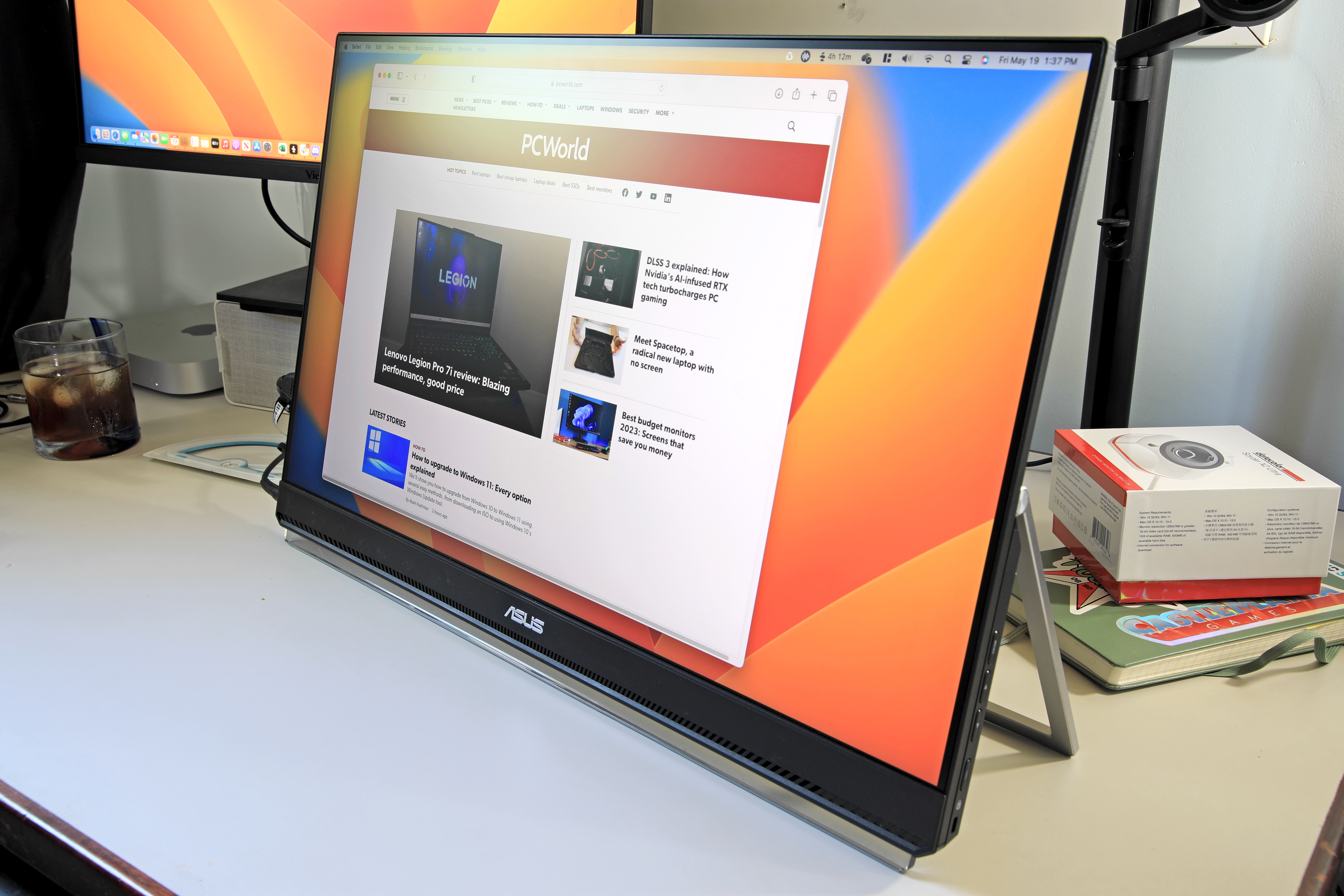
Pros
Small, versatile desk stand with unique options
Sturdy built-in kickstand for portable use
Offers USB-C for easy single-cable connections
Good image quality
Cons
Lacks additional connection options
Only 1080p resolution
A bit pricey for its feature set
Asus’ ZenScreen MB249C is a portable home office monitor that can be mounted next to a primary monitor in several ways.
The MB249C has an adjustable desk stand that can clamp to the back of your desk instead of sitting on top of it, which reduces wire clutter and keeps the surface of your desk free. The monitor also has a built-in kickstand, which is great for portable use, and a “partition mount” to hang the monitor from a vertical surface. The options end with a 100x100mm VESA mount that is compatible with most third-party monitor arms and stands. These options make the MB249C easy to place next to your primary monitor even in cramped spaces.
This is a portable monitor, as mentioned, which means it’s easy to move. The monitor mounts to its stand with a clip mechanism that’s easily detached, and the built-in kickstand can flip out to support the monitor on most flat surfaces. It’s powered by either a USB-C connection that supports up to 60 watts of Power Delivery or the included power adapter. Not everyone will need the monitor’s portable versatility, but it’s handy if you like to work in different locations throughout the day.
Once in place, the MB249C is a competent office and productivity monitor. While it lacks the wow-factor of more expensive alternatives, like the Dell U3223QE, Asus delivers a robust, colorful, and accurate image with plenty of brightness for a typical home office. The lack of features like HDR might seem disappointing but, at this price, it’s better to execute the basics well.
Read our full
Asus ZenScreen MB249C review
What to look for in a home office monitor
A great home office monitor should have a high maximum brightness, great image clarity, and vivid color. A height adjustable stand is preferable, as it helps with ergonomics, and a wide range of connectivity is useful for connecting multiple devices.
Resolution matters, but 1080p is still fine
4K is the best resolution in most situations, as it provides a sharper image and can make small fonts easier to read. This remains a premium option, however: Most 4K monitors are still above $300. A 27-inch 4K monitor has a pixel density of 163 pixels per inch.
The less well-known 1440p resolution (2560×1440) is a good option for mid-range monitors. It’s not quite as sharp as 4K, but it’s a noticeable upgrade over 1080p. A 27-inch 1440p monitor has a pixel density of 108 pixels per inch.
1080p resolution remains a good pick for budget monitors. It’s not nearly as sharp as 4K, so video may look a bit soft and small fonts may be harder to read, but it’s still adequate for hundreds of home office tasks. A 27-inch 1080p monitor has a pixel density of 81 pixels per inch.
When it comes to brightness, more is more
Brightness is a key trait for a home office monitor.
An office monitor doesn’t need to be bright to look usable: 200 nits is fine. However, a home office is likely to be brighter and to have less light control than a corporate cubical. A maximum brightness of 300 nits, or better, is ideal. You can always turn the brightness down from its maximum if it looks too bright but, of course, the reverse isn’t true.
Make sure you understand connectivity
It’s important to buy a monitor that supports a video output found on your PC. Most desktop computers will offer both DisplayPort and HDMI, while laptops often stick to HDMI. Budget home monitors sometimes support older connections, such as VGA and DVI, but these are not found on new computers. Our guide to display cables can help you identify the ports on your PC.
You only need one video connection between your PC and your home office monitor, and the type of connection you use isn’t terribly important. HDMI and DisplayPort work equally well for home office use.
USB-C isn’t a must-have, but it’s useful
USB-C with DisplayPort Alternate Mode is a new alternative to HDMI and DisplayPort. It bundles a DisplayPort connection into the familiar USB-C port now used by many devices (and soon to be required by law in Europe).
Some high-end laptops, like the Dell XPS 13 Plus, only support video output over USB-C. You can still connect a DisplayPort monitor with a USB-C to DisplayPort cable adapter, but this is a clunky solution.
USB-C, unlike HDMI and DisplayPort, can support Power Delivery to charge a connected device. This is useful for thin-and-light laptops, as it makes docking the laptop easier. Some USB-C monitors, like the Dell U3223QE, have built-in USB-C hubs that connect to multiple USB-A ports, ethernet, and DisplayPort-out. Our guide to USB-C hub monitors has the full scoop on these perks.
How we test monitors
PCWorld’s monitor reviews rely on in-depth testing by a team of staff and freelance writers. Our experts spend hundreds of hours testing and comparing monitors to find the best choice for any budget.
We test monitors with a SpyderXElite color calibration tool. This provides objective measurements for brightness, contrast, color accuracy, color temperature, gamma, and color gamut, among other metrics. These objective metrics help us compare dozens of monitors at once and eliminate bias from comparisons.
FAQ
1.
What makes a monitor good for my home office?
A home office monitor should have a high maximum brightness, which helps defeat glare, and a good range of connectivity. A height-adjustable stand is also ideal, since it will help you find a comfortable viewing position.
2.
What is the best resolution for a home office monitor?
4K is the best resolution, but expensive. 1440p resolution is a good midrange choice, while 1080p is the budget option.
3.
What ports and video connections should a home office monitor have?
HDMI and DisplayPort are by far the most common video connections on home office monitors. Most computers will have both connections. Be sure to double-check your PC’s video output support before buying.
USB-C with DisplayPort Alternate Mode is a new alternative that supports video over a USB-C connection. Though still uncommon, many high-end monitors and laptops now support this feature.
4.
Does a home office monitor need HDR?
No, a home office monitor doesn’t need HDR. Windows’ HDR support leaves a lot to be desired. HDR works better with streaming apps and games that support HDR. If you want to play games, check our guide to the best gaming monitors.
Author: Matthew S. Smith
Matthew S. Smith is a freelance technology journalist with 15 years of experience reviewing consumer electronics. In addition to PCWorld, his work can be found on Wired, Ars Technica, Digital Trends, Reviewed, IGN, and Lifewire. Matthew also covers AI and the metaverse for IEEE Spectrum and runs Computer Gaming Yesterday, a YouTube channel devoted to PC gaming history.
>>> Read full article>>>
Copyright for syndicated content belongs to the linked Source : PCWorld – https://www.pcworld.com/article/1389780/best-home-office-monitors.html































